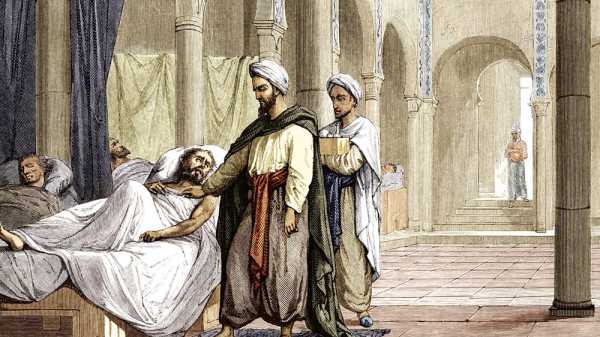With the dawn of Islam on the Bedouin, nomadic tribes of the Arabian Peninsula came enlightenment, not only strictly spiritual in nature, but also with cultural, educational and scientific connotations.
Among the fruits of this enlightenment was the eventual establishment of huge health facilities that, among other things, played an important educational role amongst physicians of the age.
The first bimaristan, as these establishments were called, was built in Damascus in 86 Hijri (707 A.D.) by Caliph Al-Waleed ibn `Abdul-Malik.
📚 Read Also: Neurology & Qur’an Speak About Smartest Bird on Earth
The aim of its construction was the treatment of acute diseases and the care of patients affected with chronic diseases (such as lepers and the blind).
Leprosy patients were not only treated free of charge but were given money to help in supporting their families.
The word bimaristan is of Persian origin and means hospital, with bimar meaning disease and stan meaning location or place; thus the location or place of disease.

The Bimaristan System:
The physicians of the Islamic world set up a concise system for bimaristans with two important aims: the welfare of their patients who were treated according to the latest in medical know-how, and teaching medicine to newly graduated physicians .
Bimaristans were constructed on sites that would provide optimum health conditions for patients. They were preferably built on hills or by rivers.
Al-`Adadi’s Bimaristan is a good example of this; it was built in Baghdad by the River Tigris, where the water of the river flowed through its courtyard and halls to return and pour back into the Tigris .
When Haroon Ar-Rashid asked Ar-Razi to build the first general hospital, Ar-Razi selected a site after putting pieces of meat in different areas of Baghdad to look for a location with the best fresh air.
Concerning organization, bimaristans were divided when possible into two sections, one for men and the other for women. Each section was independent, with large halls for the patients.
Each section of a bimaristan contained a hall for every type of disease, while each hall had one physician or more and each group of doctors in a section had a chief doctor.
The halls were specialized: a hall for internal diseases, another for splinted patients (trauma and fractures), another for deliveries and a special hall for each type of disease including communicable diseases.

Click to read more…
Pages: 1 2 3
